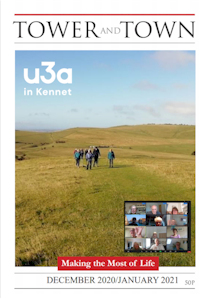

Tower and Town, December 2020 (view the full edition) (view the full edition)Wildlife In AveburyAs the new nature correspondent I thought I ought to introduce myself: Fully retired from a lengthy career as a music teacher, latterly at Marlborough College, I now live in a village partly managed by the National Trust, which attracts many tourists, dog walkers, bikers, druids and stone-worshippers. Not the obvious place perhaps to encounter much wildlife but I have been surprised at what there is within the parish of Avebury. Even in the centre of the village the great barn houses five species of bat and the adjacent pond is home to the protected great crested newt. On the sports field thirteen apple trees have recently been planted and hedgerows replanted with natural enrichment in mind. As an offshoot of the Marlborough Downs Natural Improvement Area Project a so-called ‘Bee Road’ has been created between Marlborough and Broad Hinton, passing through Avebury, and this has ultimately led to an increase in the number of visiting bees and other pollinating insects, as well as wild flowers. Up on the higher levels we frequently see groups of roe deer, and hares are often spotted running back and forth. Because of the increased cases of hare coursing the local farmer has blocked off access to some fields with huge tree trunks, even creating ditches that make vehicular access impossible.  My main interest in the flora and fauna is in the birdlife that occurs in what is a rural farmland habitat nestling below the Marlborough Downs. During the lockdown periods in particular regular dog-walking along local tracks has been an important antidote to cabin-fever and as a result I have seen more species than usual, from early Spring through to late Autumn. Chiffchaffs, blackcaps and whitethroats were singing from late March onwards and April saw the arrival of our swallows and house martins. Migrants have included spotted flycatchers, redstarts, wheatears and whinchats and one of the most glamorous of our local breeders, the yellow wagtail. A delightful surprise was the brief sighting of a wryneck on the approach to Windmill Hill in early September, a real rarity. Skylarks, corn buntings, yellowhammers and tree sparrows are absent from some parts of the U.K. but they are holding their own here. Now the hedgerows are full of chattering fieldfares and ‘seeping’ redwings, a flock of chaffinches include a brambling or two and golden plover move as one in a tight flock above Windmill Hill. Robin Nelson |